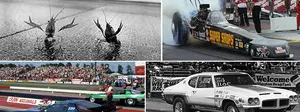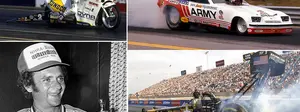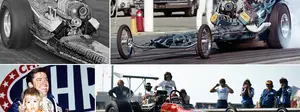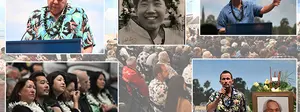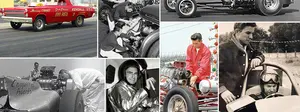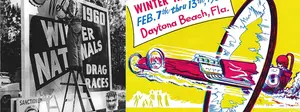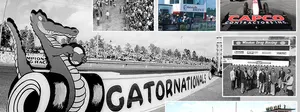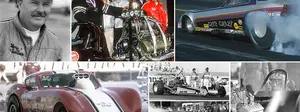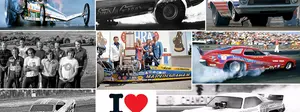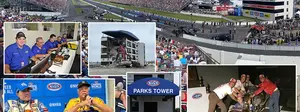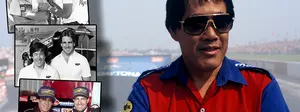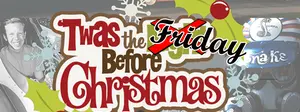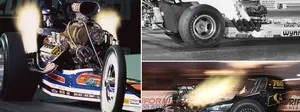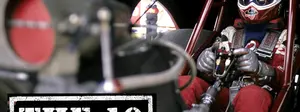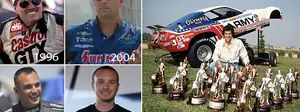Kuhl & Olson
 Driver Carl Olson, left, and tuner Mike Kuhl ran Top Fuel together in the early 1970s and won some of the era's biggest events. |
When Mike Kuhl and Carl Olson were inducted into the International Drag Racing Hall of Fame in 2012, presenter Steve Gibbs noted in his introduction that although both were worthy of induction by themselves, it was fitting that they be inducted as a team, and their names were forever bound in much the same way one might think of Warren & Coburn, King & Marshall, Sox & Martin, and Candies & Hughes.
Together they formed one of Southern California’s most popular and successful tandems in the early to mid-1970s with their line of Kuhl & Olson dragsters, both front- and rear-engine. Together, they won some of the region’s great races, including the NHRA Winternationals, the March Meet, and The Last Drag Race at Lions Drag Strip, and an IHRA world championship.
Kuhl was a St. Louis transplant who came to the West Coast in the mid-1960s and learned how to build engines at the knee of Louie Unser in his shop in Santa Ana, Calif. He fielded a fuel dragster in the late 1960s with Billy Tidwell and Steve Carbone driving and in 1970 opened Mike Kuhl Racing Engines.
 (Above) Olson took a wild ride at Fremont in the Olson & Bowman car in March 1971. (Below) Partner Don Bowman, left, surveyed the damage, which was so extensive that the car could not be repaired. |
 |
Olson, a lifelong Angeleno, cut his drag racing teeth in Jr. Fuel and Top Fuel, partnering with a number of teams leading up to his competitive 1969 Top Fuel ride with Bill Stecker and Jack Ewell before striking out on his own in 1971 with the Woody Gilmore-built Black Plague II car, which he purchased from Frank Rupert and Steve Pick. Rupert and Pick had owned the first Black Plague car, which was destroyed in a crash that claimed the life of John Martin while on loan to him. Apparently affected by the tragedy, Pick got out of racing, and Rupert couldn’t afford to run the car himself and sold it to Olson at a good price. Meanwhile, an old friend, Don Bowman, had just crashed his car, and rather than stay completely out of racing, he partnered with Olson and provided the 354 Chrysler Hemi power. It turned out to be a very short-lived endeavor for both, cut short after a few months – after solid outings at both the NHRA and AHRA Winternationals – by a crash in March at Fremont Raceway in Northern California.
"I burned some pistons, got a face full of oil and fuel, and drifted off the left side of the track," recalled Olson of the crash that destroyed the car. "I was doing fine until I got to the first paved turnout, which launched the car and got it upside down."
At about the same time, Kuhl had split with his most recent driver, Dick Rosberg, and was looking for a shoe. Olson had driven Kuhl’s car the previous July, and they reunited in March 1971.
At their Hall of Fame induction, Olson told a funny story about that first ride in Kuhl's car. On his first qualifying pass at Orange County Int'l Raceway, the car hiked and carried the front end a long way. Knowing that traction would only improve later in the day, Olson was not comfortable with the setup, asking Kuhl to either hang some weight on the nose or loosen up the clutch; Kuhl, typically, declined to do either.
 Olson's first ride in Kuhl's car was a memorable one. (Steve Reyes photo) |
Sure enough, in round one against Hank Westmoreland in the Allen Family car, Olson had his hands full with the front end way in the air way downtrack, the car rocking back and forth on the "fifth-wheel" wheelie wheel, and finally, discretion being the better part of valor, Olson stepped off and reluctantly conceded the round.
Kuhl appeared to take the loss well, at least until he thought Olson was out of earshot. Olson was on the other side of the trailer to put away his driving suit when a friend dropped by and asked Kuhl why they had lost the round. Kuhl's answer was succinct: "Driver error."
The timing of the Kuhl & Olson partnership dovetails with recent columns here about that transitional time between the demise of slingshot dragster design and the beginning of the dominance of the rear-engine design beginning with Don Garlits’ Winternationals win in 1971.
Before I go any further, in the interest of full disclosure, the very cool information provided herein is not the result of hours of research on my end but rather the product of Olson’s generosity in answering in great detail what could basically be called a fan letter. Sometimes in this writing business, you have to work really hard to come up with an interesting story, and other times, it kinda just falls into your lap. This week’s column is a case of the latter.
As mentioned previously, I had connected Olson with master model builder Mark Gredzinski, whose eye for detail, unquenchable thirst for any piece of 1970s drag racing trivia, and skillful hands have created – usually by hand – some of the most realistic 1970s-era drag racing cars and engines ever seen. Gredzinski wanted to build a K&O replica of the highest order and had a ton of questions, which Olson not only answered, but also did so in thrilling (for Gredzinski and me, at least) detail. I was copied on all of their communication and use it here as the basis of this column. My job was to compile the vast amount of info, sew it together into a manageable narrative, and create the front story. I did have a few follow-up/fill-in-the-details questions for Olson beyond what he wrote, and he quickly obliged. I’ve known Olson for decades – we were co-workers here at NHRA for a number of years – and through him met Kuhl. Both have been great inspirations, and Olson certainly has contributed a lot of insight to this column over the years to help me sort through various stories.
But back to the story …
 (Above) The Kuhl & Olson front-engine car at the 1971 NHRA Springnationals in Dallas. (Below) Their first RED, at the 1971 Nationals, where they accepted the Best Appearing Car Award from NHRA's Jack Hart. (Reyes photo) |
 |
 Olson in the winner's circle after winning the 1972 NHRA Winternationals. |
 (Above) Olson beat tire-smoking Dave Settles in the semi's at the 1972 IHRA event in Dallas, but disaster loomed. (Reyes photo) Olson beat Flip Schofield in the final, but a major engine failure led to a crash and a car-less winner's circle (below) with IHRA's Larry Carrier. Recalled Olson, "Carrier wanted us to drag what was left of the car out of the trailer for the photo, and Kuhl told him, 'No way.' Kuhl was not particularly proud of what happened to the car and insisted on laying the winner's trophy down to represent our mood." (Jon Asher photo) |
 |
It didn’t take long for both Kuhl and Olson to see that the rear-engine dragster was going to revolutionize the class and took just a few ticks longer for them to get one on order that summer from master chassis craftsman Woody Gilmore.
“We saw the handwriting on the wall with Gar's rear-engined dragster and wasted no time in ordering one from Woody,” said Olson. “Many racers were far less convinced than we were and stuck with the front engines much longer than we did. Some of them thought the rear-engined dragsters were just a passing phase, but many others simply didn't have the financial means to make the change even though they may have wanted to. They felt that as long as their cars were competitive, they'd run them as long as they could.”
The new car made its debut at a regular Saturday night event at Lions Drag Strip, where it went a full tenth of a second quicker than the front-engine dragster on its very first full run.
“We knew right away that we'd made the right decision to go RED,” recalled Olson. “We ran the car once at Orange County Int'l Raceway before towing back to Indianapolis for the 1971 NHRA Nationals, where the car was awarded Best Appearing. We ran the car locally for the brief remainder of the 1971 season.”
The car was still relatively new for the start of the 1972 season and carried them to victory at the Winternationals and, shortly thereafter, to a runner-up at the March Meet in Bakersfield. That success convinced the duo to take their act on the road and go on tour.
“We ran mostly NHRA and four IHRA national events and numerous match races and booked-in shows,” he said. “We were runner-up at the IHRA Longhorn Nationals in Dallas, again at the NHRA Springnationals in Columbus, and won the IHRA Pro-Am at Rockingham, N.C., before winning the IHRA Nationals, again in Dallas.”
They won the IHRA championship that year, but the win in Dallas came at a huge price. A “catastrophic engine failure” led to a nasty crash that all but destroyed the car, save for the cockpit and roll cage.
The team had broken the crankshaft in its Donovan 417 in Indy and had installed a spare engine – a cast-iron 392 Chrysler – for a match race in Wichita, Kan., and the Rockingham event. Following their win over Tommy Ivo in Rockingham, Kuhl discovered that the main webs in the block were seriously cracked, and the plan was to take an early-round loss in Dallas and beat it home to California to begin work on a new 417.
But that was before their first-round opponent, Oz Hay, kicked the rods on his burnout, and their second-round opponent, Dale Funk and the Frakes & Funk Kentucky Moonshiners car, couldn’t fire for round two after shearing a fuel-pump driveshaft in round one. Olson singled for both round-wins, squirting the car off the line and coasting through the traps to light the win lamp.
“After each round, Kuhl dropped the pan and checked the block and observed that the cracks didn't appear to be getting any worse,” said Olson. “In the semifinal, we raced Dave Settles in the Carroll Brothers car, which smoked the tires. I drove down to the 1,000-foot mark and clicked it, and Dave never came by. All of a sudden, we're in the final against Flip Schofield, who we'd beaten every time we ever raced him. With a $10,000 prize for the winner, we carefully considered our situation.”
The 1,000-foot run had increased the cracks in the main webs, but not significantly. The duo weighed the risks and decided to run the final with the proviso that Olson should step off the gas if he felt uncomfortable with the pass. Olson left on Schofield and never saw him until the 1,000-foot mark.
“Just as I was getting ready to click it off, I saw his front wheel out of the corner of my eye, and I was pretty sure that if I drove another hundred feet or so, I could still beat him to the finish line,” he recalled. “The good news is that I did beat him to the finish line. The bad news is that the block split in half, allowing the crankshaft, rods, pistons, etc. to fall out of the engine. I subsequently ran over the entire rotating assembly, which took the rear end, axles, wheels, and tires with it. What followed was the wildest ride of my life. Only a superior car and safety equipment allowed me to literally walk away from the wreckage once the car stopped sliding down the shutoff area. As I was sliding backward down the track, I could see and feel the fire from the engine but suffered no serious burns. We had photos taken on the starting line with the trophy but no car, collected our prize money, and retired to a local motel, where I took a hot shower and went to bed. Kuhl went to dinner and the bar."
Fortunately for the boys, they already had a second car ordered prior to the crash. That car was built to take advantage of revisions that Gilmore had come up with since the first car; the technology of the new design was accelerating almost as fast as the cars themselves.
 Just two weeks after the Dallas crash, the team debuted a new car at the 1972 NHRA World Finals in Amarillo, Texas (Reyes photo), that carried them to a very emotional win at Lions' Last Drag Race (below). |
 |
 The finished, painted, and detailed second RED, along with the rebuilt first RED, which was sold to Clive Skilton, far right. (Reyes photo) |
 (Above) The pretty new car cackled under the lights at Orange County Int'l Raceway. (John Shanks photo) The nice paint job lasted only until K&O signed a deal with Revell, which came up with the unique yellow paint scheme (below) that led the car to be nicknamed "the Banana from Santa Ana." |
 |
 It took an unorthodox bit of carry-on luggage for the team to compete at the 1973 U.S. Nationals after an off-track excursion by a fill-in driver the week before damaged the front end. Note that the car is missing its front-wing fairings. |
“Woody was being swamped with RED orders, and we were concerned that because a great many teams were planning on switching over from FEDs to REDs over the winter, we didn't want to find ourselves at the end of a long line,” remembered Olson. “The next morning, we called Woody to tell him what happened, then drove straight through to RCE, arriving on Tuesday afternoon only to find that the chassis was already completed and had been sent to [Tom] Hanna's for the body, seat, and fuel tank.”
Just two weeks later, the new car competed at the NHRA World Finals in Amarillo, Texas, and the NHRA Supernationals in Ontario, Calif., before scoring the team’s emotional win at the Last Drag Race at Lions.
Before it crashed, the '72 car was set to become the property of North Carolina racer Jim Hildreth, who also wanted to upgrade from a slingshot to a rear-engine dragster. He had even put down a deposit with the boys and hoped to take delivery of the car after the Finals, but those plans were scotched by the crash. He got his deposit back and later bought a car from someone else.
Gilmore put new front and rear sections on the crashed car, and after Hanna fashioned a new body for it, the car was sold to English racer Clive Skilton, who ran it at the 1973 NHRA Winternationals, then shipped it home to England. He later crashed and rebuilt it, then sold it to Liz Burn, who also crashed it, ending the car’s interesting life.
The end of the 1972 season also marked the end of the duo’s extended touring as they promised wives and families that they would race closer to home. Kuhl reopened his engine-building business, Olson took a job as general manager at Waterman Racing Engines, and they finished detailing the new car for the 1973 season. The car was painted red, white, and blue by George Cerny and lettered by Nat Quick, and both Kuhl and Olson agree it was their prettiest car ever.
Early that year, they were invited to join the impressive lineup of quality cars under the burgeoning Revell banner, and the car had to be repainted in the Revell colors and trim, a bright yellow that led to the ignominious nickname of “the Big Big Banana from Santa Ana.”
“It won't come as much of a surprise that Kuhl and I weren't all that happy about it, but, as they say, money talks,” he said. “The stated aim of the Revell art department was to create paint and graphic schemes intended to make the cars instantaneously recognizable to even the most casual fan/potential model buyer.
“They certainly accomplished that,” he added, tongue firmly in cheek. “There wasn't another car that looked anything like it, that's for sure. Mission accomplished.”
Although they weren’t touring per se, they didn’t miss the granddaddy of them all, the U.S. Nationals, where they scored runner-up honors behind repeat winner Gary Beck. Again, glory didn’t come easy.
The week before the Nationals, Les Allen – of the famed Allen family – was tapped to drive the car at the PDA event in Tulsa, Okla., because Olson was dealing with a severe eye infection and unable to travel, let alone drive the car. Unfortunately for all, Allen ran the car off the edge of the track and heavily damaged the front axle, fairings, radius rods, and steering rods.
“Kuhl called me and instructed me to get Woody to build a new front-end assembly and to bring it with me to Indy,” said Olson. “Woody was way too busy to do so on such short notice but advised me that he'd just sold a complete chassis to a good friend of ours, George ‘the Bushmaster’ Schreiber, who lived not far from me in Long Beach. I called George and explained our situation, and he said I should get over to his place immediately. By the time I got there about an hour later, he'd already removed all the key parts from his new chassis, and we loaded them into my pickup truck, and I hauled them home. Two days later, I flew to Indy. I didn't want to check the parts as baggage, as I was sure they'd be lost or damaged, so I took them on the plane with me.
"While I was attempting to board, the flight attendant told me there was no way I could take that stuff into the cabin. After I explained our situation to her and how critical it was for the parts to get to Indy with me, she just shook her head, looked the other way, and waved me onboard. I had a window seat and simply slid the axle and parts under my seat and the one in front of me right up against the bulkhead. Later in the flight, the attendant confessed that she and her husband were race fans and, as a result, understood my story was on the up-and-up. Needless to say, flying was a lot different back in the early '70s than it is today. When I got to Indy, we bolted the new front end on the car, adjusted everything, and went out and got runner-up to Gary Beck.”
The ’73 car was sold to Terry Hudson, who ran it under the name California Wolverine with drivers John Zendejas and Denver Schutz, then sold the car, at which point, “It seems to have disappeared into drag racing history,” said Olson. “Kuhl and I tried, in vain, for many years to locate this car for acquisition and restoration.”
 At the 1974 March Meet., Kuhl and Olson were certainly "Da Revell Fast Guys" as they won the race, set both ends of the performance standards, and earned the 14th spot in the Cragar Five-Second Club. (Jere Alhadeff photo) |
Gilmore built the team a new car for 1974, which got off to a flying start with a huge win at the March Meet, where it was low qualifier, set low e.t. and top speed, won the event, and, with the first five-second runs ever at fabled Famoso Dragstrip, became the 14th member of the exclusive Cragar Five-Second Club.
They ran the car locally and at a handful of NHRA national events, but at the end of the 1974 season, Olson retired from driving to pursue a career in motorsports.
He and Kuhl continued to campaign the car through the 1975 and 1976 seasons with the likes of Bill Tidwell, Rick Ramsey, and Pat Dakin taking the saddle. Skilton again proved to be their best used-car customer and ran the car at several NHRA meets, including the 1977 Springnationals, where he went into the history books as the first non-North American to reach an NHRA Pro final, albeit coming up short in the money round to Shirley Muldowney’s second straight Columbus win.
Skilton again shipped the car home, ran it for some time, then sold it, yet Olson kept a watchful eye on it and noted that it ended its career as a Top Methanol (Alcohol) Dragster campaigned by Brian Hazelton. In his role as president of the FIA Drag Racing Commission, Olson saw the car run a number of times at England’s Santa Pod Raceway, where he shared firsthand with Hazelton and crew some of the car’s rich history.
 Olson, right, and Kuhl at their 2012 Hall of Fame induction |
Olson went on to a decorated career in motorsports that included long tenures with NHRA and SEMA and continues with his work with SFI. He also became an accomplished racer in other forms of motorsports and is a member of the prestigious Bonneville 200-MPH Club. Kuhl expanded his engine business to include superchargers, then sold his business in 2001 and opened Kuhl Klassic Restoration, where he is one of the go-to guys for the many restorations and re-creations of vintage drag racing machinery. Together, the duo was celebrated in 2007 with a Lifetime Achievement Award at the California Hot Rod Reunion presented by Automobile Club of Southern California.
So there you have it, the very cool (Kuhl?) story of Kuhl and Olson. Thanks so much to Carl for his thoroughness, to Mark for creating the opportunity, and to the readers for their support.















